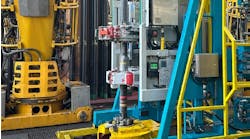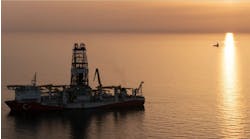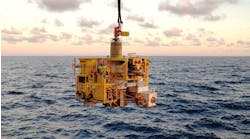Deep, ultra deepwater capex spending predicted
This month Infield Systems Ltd. looks at deep (500-1,499 msw) and ultra deepwater (≥1,500 msw) development drilling activities and production technologies. The production technologies covered include platforms, subsea equipment (templates, manifolds, PLEMs, PLETs), and pipelines and control lines.
The period 2007-2011 is forecast to see a near quadrupling in the number of deep and ultra deepwater development wells that may be drilled and completed, relative to the previous five-year period. This translates into a higher drilling capex outlay for the forecast period. Figure 1 depicts the regional deep and ultra deepwater development drilling capex (spent and forecast) as a percentage of the global total by year of spend.
Africa is expected to account for the largest share of the total global forecast followed by Latin America, North America, Asia, and Australasia. The rate of increase in North America and Europe is forecast to be relatively lower than that in the other regions. Deepwater drilling and completion is more expensive than that for shallow water (≤500 msw) and therefore deepwater is expected to be a key driver of drilling activities as well as capex outlays.
In terms of the regional spread of total global platform capex (Total Installed Cost - TIC) outlay for 2007-2011, Asia is expected to have the highest rise relative to the 2002-2006 period. Asia is followed by Latin America, Africa, Europe, and Australasia. North America’s outlay for deep and ultra deepwater platforms is expected to decline relative to the previous period, but development of new Lower Tertitary finds like Jack could well reverse this trend.
Additionally the accompanying figures 3 and 4 depict the regional share of global deep and ultra deepwater equipment capex (TIC), and pipelines and control lines capex (TIC) from 2002-2011, respectively. A key point to note from the figures is the increasing trend of global deep and ultra deepwater activities beyond the regions of North America, Africa, and Latin America. Asia, Australasia, Europe, and even the Middle East and Caspian regions are forecast to foray into this niche segment of the oil and gas industry.
Editor’s note: The relative costs involved with any one ultra deepwater project put those projects into a different category than the typical offshore project. Because each ultra deepwater project is so much more expensive than work in shallower depths, a small change in the number of actual projects can make a big change in the capex percentages. As mentioned above, for instance, another GoM find on the same order as Jack could increase the percentage of capex spending for North America and also increase the rate of growth figures. For that reason, the regional share of equipment and pipeline spending worldwide can be affected by a single new discovery.
Another element which can affect the spending, particularly in the capex figures, is product development. Producing from ultra deepwaters is disproportionately expensive just like the drilling. If new technologies are made commercial that contribute to producing from a given ultra deepwater geographic area or type of production, the regional percentages of capex spending can change dramatically. That also can affect the type of capital expenditures. In some target areas, drilling is planned in water depths that exceed existing production capabilities. If discoveries in these water depths are sufficiently large, technological developments to permit commercial production historically will follow. Over the time span discussed here, a shortage of drilling rigs able to work in such water depths could retard the growth in spending in drilling, but be offset by increased rate of spending for production and pipeline equipment as the technological developments keep pace with the drilling depths.
Ojus Palathingal,
Researcher
Dr Roger Knight,
Editor & Offshore Data Manager










